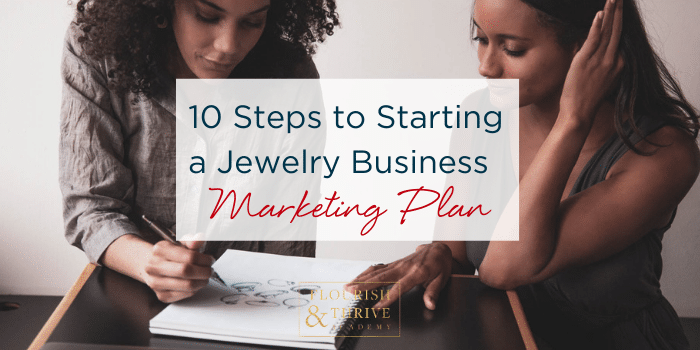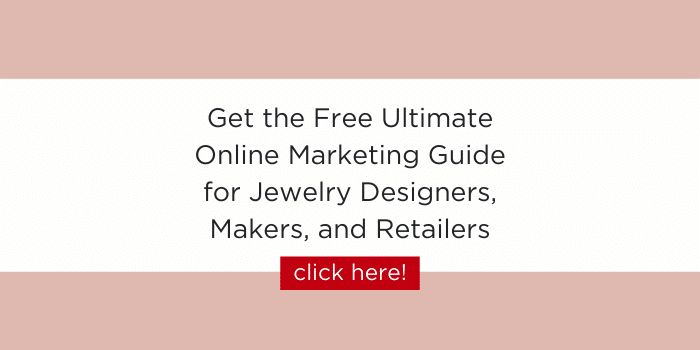10 Steps to Starting a Jewelry Business Marketing Plan

Whether you’re looking to grow your jewelry brand into a profitable side hustle or a booming full-time business, the work doesn’t stop after you register your business name. Once you’ve got the legal steps sorted out and an amazing collection ready to go, it’s time to get serious about creating a marketing plan for your jewelry business.
Marketing covers many different channels and projects, and there are quite a few steps to take when starting out. Launching any business can seem overwhelming, but don’t worry! It’s not as challenging as you might think (especially with guides like this one to help you out!).
Before we dive in – we want to make sure you've got your copy of our Ultimate Online Marketing Guide for Jewelry Designers, Makers, and Retailers. It's totally free and will guide you through the complete process of creating your marketing plan and staying organized! Click below to download your copy.
Conduct Market Research
Before you get carried away with making social media posts or sending out emails, it’s important to start out with a strong marketing foundation. This process starts with market research to help you understand trends, competition, and who your target audience is. A thorough market analysis explores the size of the market, its value and opportunity, as well as potential roadblocks.
Market research involves the following factors:
- Demographic research
- Identifying your target audience
- Market need
- Competition
- Barriers to entry
- Regulations
Define your target audience through a buyer persona
A buyer persona is a fictional representation of your ideal customer based on market research. Defining a buyer persona puts you in the mindset of your customer and helps you understand their needs, wants, and motivations for buying your product.
The buyer persona for a jewelry designer who sells gold diamond necklaces is certainly different for artists who create homemade, customizable toe rings.
Once you know your buyer persona you can then define the buyer’s journey process. A buyer’s journey helps identify when, how and exactly where your customer will find your jewelry and the type of information they need to make a purchase.
Competitive analysis
Now that you’ve carved out your niche, studied market trends, and identified your ideal customer you now need to evaluate the competition.
Identify the biggest players in your market and analyze their pricing model, types of jewelry they offer, customer service and fulfillment policies, and their marketing strategy. Where and how do they advertise? A deep dive into their social media presence and online reviews can help identify weaknesses or missed opportunities for you to capitalize on.
Using what you know about your target audience and competition is key to developing a solid marketing plan.
Define Your Unique Selling Point
Now that you have a clear vision of who you’re selling to and the other similar brands in your space, it’s time to define what sets you apart from the competition. A unique selling point is just that: the specific aspects that make your brand different and better than other options your customers may have.
You’ll want to take a broad look at your business and products and make a list of the qualities that make you unique. Are your designs completely original? Do you have the best quality gemstones in your niche? Do you offer a specialized custom design process unlike any other? Are you top rated in ethical sourcing?
While you don’t need to be completely different from competitors in every category (in fact, this is nearly impossible!), knowing the areas that are your strengths and being able to define them will help immensely when defining your brand and marketing strategy.
If you need a little extra help to get a clear vision of what your unique selling point is, consider asking 5-10 people who aren’t deeply familiar with the brand to review your materials and products and provide a list of qualities and impressions they have about the brand. Comparing common threads between these answers can help define your unique selling point in an accurate, non-biased way.
Define Your Jewelry Brand
Your name and jewelry design should start to play into the development of who you are as a brand. A word of caution? Don’t be too hasty when selecting your jewelry business name. Your brand will be a unique look and feel that separates you from the competition and is what your customers will identify with, and a strategic name is the first part of that process.
Other elements of branding your jewelry business to consider include your company logo, colors, website pages, ads, packaging, and photos. Additionally, fine tuning your messaging and brand voice is also important when engaging with customers on social media and other online platforms. Each of these elements should be defined before you begin any marketing projects to make sure that your brand looks and feels consistent across all online platforms.
Take Great Photos for Your Website and Social Media (or Hire a Product Photographer)
Now that you have your business established and a beautiful jewelry collection ready to sell, it’s time to create images that showcase your work to impress your customers. When it comes to creative product businesses, images are one of the most important, and effective marketing tools at your disposal. Brand and collection photos should be used on your website, social media, and even for print collateral such as business cards or signage.
Make it a priority to take consistent, quality photographs of your collections. This factor is key to help your business look professional and also assist with making more sales online and off. Having great photos is the first gateway to get a buyer to notice your work.
There are two options for checking this step off your list. First, take the jewelry photos yourself! Invest in a quality camera and learn how to stage and shoot your own brand images. Depending on your skills, interest, and time, this will take some practice.
Another option is to hire a professional product photographer. They will know exactly what and how to shoot your collection to make it look top-notch. This route is definitely more expensive, but less stressful and likely quicker than taking them yourself.
Identify Your Inbound and Outbound Marketing Channels
Now that you’ve done your research and defined your core brand elements, you’re ready to start building your marketing plan. The first step is to decide which marketing channels you want to focus your energy on. Chances are, you don’t have a 20-person marketing team or million dollar budget to tackle every type of marketing under the sun, and that’s okay! Lack of resources doesn’t mean you can’t craft an effective marketing plan for your creative business.
What it does mean is that you should take the time to determine the most strategic channels to focus on so your efforts go farther for your business. Marketing channels are typically divided into two different categories: inbound and outbound. Outbound marketing is where you actively are seeking out engagement with potential buyers. This could mean hosting trade shows, attending wholesale shows, calling up customers directly, or reaching out to PR opportunities or partnerships.

On the other hand, inbound marketing is built around the idea of creating content that might attract potential customers to you. This looks like posting on social media, creating blog posts, or offering free guides online to drive website traffic or build your email list.
You’ll want to decide which platforms get priority in your business. A brief list to consider includes: your website, blog, social media, email list, and PR outreach. Since we specialize in helping jewelry designers get their offline business online, we’ll be walking you through 3 inbound marketing and 1 outbound marketing strategies in the following steps.
Optimize Your Website
Investing time in optimizing your website for search engines is crucial to getting your online jewelry store in front of potential customers. Search engine optimization tactics like keyword research, developing a blog, and promoting your product pages to influencers and other online publications help make your site relevant to Google and drive traffic.
Alongside working on efforts that drive traffic to your jewelry brand’s website, you’ll want to constantly audit how effective your website is at encouraging users to buy once they’re on the website. After all, sales conversions are the most important part of marketing your website. If your website is confusing, difficult or slow to use, or doesn’t take the user on a journey ending in one of your products, you have some work to do!
As the home base of your brand, these two elements of optimizing your website should be a top priority when developing your marketing plan.
Create Your Social Media Plan
Today there are so many social platforms a business can market their products on. They each offer unique features and methods for staying in contact with your online audiences. Here’s a list of the most popular social sites currently used:
- Youtube
- Tiktok
These are all fantastic options for sharing photos, and running ad campaigns to get your jewelry in front of your ideal customer. It’s important to consider each platform and determine which ones are the most important to focus your efforts on. If that sounds like a challenge, go back to the basics. Your marketing plan is designed to help your business make more sales, so you want to select the social media platforms where your customers are most likely and frequently hanging out for the best chances of success.
Once you’ve decided on the social media platforms for your jewelry business, you’ll want to consider the tasks needed to be successful. These might include: Brainstorming and creating content, writing effective captions, engaging consistently with your audience, and optimizing your profiles for sales. Posting frequently and actively engaging with your audience helps build loyalty and further defines your brand.
Start Building an Email List
Email marketing is a great way to keep in touch with your customers and get repeat business. In fact, it’s been deemed one of the most effective marketing channels for making sales by marketers around the world. While creating and growing your email list is a long-term and ongoing effort, it’s important to be consistent with your efforts.
To create an email list, you’ll need to sign up for an email marketing tool. Some popular options to consider are Omnisend, Klaivyo, Mailchimp, and Convert Kit. These tools make it easy to track, segment, create, and schedule email campaigns as part of your marketing plan.
Once you’re set up with a tool, you’ll want to get people to sign up for your list. There are many ways to build an email list through your website and social media by offering free guides or lead magnets, hosting promotions and giveaways, opt-in forms on your website, or from attending markets and local events.
Develop Your Public Relations Strategy
Public relations covers everything from being featured in a magazine, to grabbing a guest spot on a podcast, to having a celebrity wear your jewelry on the red carpet. PR is a powerful way to expose your brand to new audiences and drive interest and traffic to your website and social media accounts.
As an outbound marketing tactic, however, in most cases it’s up to you to send pitches to various outlets for a chance to be featured. Until you’ve really made it in the big leagues, or get lucky, it’s up to you to let reporters, writers, and stylists know about your jewelry or creative product brand.
You’ll want to make a list of the opportunities you’d like to be featured in, find the proper contact, and pitch your story and products for the chance to be selected. This should be a regular part of your marketing strategy.
Keep Your Marketing Plan Organized
With all these different marketing strategies, platforms, and projects going on, it can be easy to get stressed out trying to keep up with it all. That’s why the final step in developing a marketing plan for you jewelry business is to stay organized. Whether you’re a team of one or many, documenting your plan and the progress you make is crucial to staying on track and launching winning marketing campaigns. Here are three key areas to consider.
- Calendar or Timeline
Ideally, instead of creating marketing campaigns on the fly for the current week, you’ll have a calendar or timeline to help you plot out campaigns for the next quarter, or even the next year ahead. This can be a simple plotting of dates or a more in-depth outline of the dates and tasks needed to be completed. Using a paper agenda or calendar, digital calendar, or spreadsheet are all great options.
- Project Management System
With so many different projects being produced at the same time, alongside your other business operations, a project management system can help make sure things don’t get lost in the hustle. There are many digital offerings available currently, varying in features and price ranges. A few of our favorites include; Asana, Trello, and Airtable.
- Notes
Do you have a set method for taking and keeping track of your notes? Whether a hard copy on paper or all-digital in the Google suite, it’s a good idea to have a process for these notes on your marketing projects to make sure your brilliant ideas stay organized, clear, and useful for when you or a team member revisits them.
Put Your Jewelry Marketing Plan into Action
Congrats! After completing each step in this post, you will be well on your way to establishing a well-rounded marketing plan for your jewelry business. Cheers to making more sales through the power of marketing this year!
If you really want to level up and get all even more info and ideas for developing a marketing plan for your business, grab your free copy of the Ultimate Online Marketing Guide for Jewelry Designers, Makers, and Retailers.

